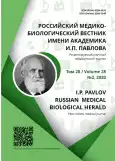Methods for improving the results of using a synthetic prosthesis in the popliteal-tibial segment in critical limb ischemia
- Authors: Matyushkin A.A.1,2, Lobachev A.A.3
-
Affiliations:
- Russian National Research Medical University named after N. I. Pirogov
- City Clinical Hospital named after D.D. Pletnev
- City Clinical Hospital named after the Bakhrushin brothers
- Issue: Vol 28, No 2 (2020)
- Pages: 200-212
- Section: Original study
- URL: https://journal-vniispk.ru/pavlovj/article/view/34908
- DOI: https://doi.org/10.23888/PAVLOVJ2020282200-212
- ID: 34908
Cite item
Abstract
Aim. Analysis of immediate and long-term results of using a synthetic prosthesis for femoral-distal-popliteal and tibial bypass grafting in patients with critical lower limb ischemia.
Materials and Methods. Patients with symptoms of chronic arterial ischemia of the lower extremities in the stage of critical ischemia (n = 109) were operated at the university surgical clinic on the base of D.D. Pletnev City Clinical Hospital, Moscow, in the period from 2009 to 2017. All the patients underwent the operation of femoral-distal popliteal or femoral-tibial bypass grafting using a synthetic explant (PTFE). Shunting with a synthetic prosthesis was performed in 33 (30.3%) patients, and in 76 (69.7%) cases a combination of an explant with a section of autovein was used in the form of a combined shunt in 44 patients (40.4%) (synthetic prosthesis + autovein) or a patch- or cuff plasty of distal anastomosis in 32 patients (29.3 %). In 14 (12.8%) patients of both groups, the intervention was supplemented by intraoperative balloon angioplasty of the lower leg arteries. Long-term results were evaluated within the period up to 5 years after surgery. Kaplan-Meyer survival analysis was used for the calculation of results.
Results. The cumulative 5-year patency of the synthetic prosthesis was 42.9%. However, use of the prosthesis in combination with the autovein section in the form of a combined shunt or plastic surgery of the distal anastomosis significantly improved the values of cumulative patency (54.5%) and limb retention (83.6%).
Conclusions. The results obtained make it possible to recommend the use of a synthetic prosthesis in combination with an autovenous plastic surgery of a distal anastomosis or by combining a prosthesis with a small section of an autovein in the absence of a complete autovein. Regular monitoring of such shunts in the long-term period and timely follow-up interventions are necessary for improving long-term results.
Full Text
##article.viewOnOriginalSite##About the authors
Andrey A. Matyushkin
Russian National Research Medical University named after N. I. Pirogov; City Clinical Hospital named after D.D. Pletnev
Author for correspondence.
Email: iplobachev@yandex.ru
ORCID iD: 0000-0002-4112-7732
SPIN-code: 5794-6214
ResearcherId: B-7734-2018
MD, professor of the department of faculty surgery of the pediatric faculty, MD, head of the department of vascular surgery
Russian Federation, MoscowAlexey A. Lobachev
City Clinical Hospital named after the Bakhrushin brothers
Email: iplobachev@yandex.ru
ORCID iD: 0000-0002-1361-9967
MD, PhD, Head of the Surgical Department of the Polyclinic
Russian Federation, MoscowReferences
- Pokrovskiy AV. Klinicheskaya angiologiya. Moscow: Meditsina; 2004. (In Russ).
- Asher E. Sosudistaya khirurgiya po Khaymovichu. 2nd ed. Moscow: BINOM. Laboratoriya znaniy; 2012. Vol. 1.
- Norgren L, Hiatt WR, Dormandy JA, et al. Inter-society consensus for the management of perepheral arterial disease (TASC II). Journal of Vascular Surgery. 2007;45(1):S5-67. doi: 10.1016/j.jvs.2006.12.037
- Sottiurai VS, Lim Sue S, Feinberg EL II, et al. Distal anastomotic intymal hyperplasia: biogenesis and etiology. European Journal of Vascular Surgery. 1988; 2(4):245-56.
- Griffiths GD, Nagy J, Stonebridge PA, et al. Randomized clinical trial of distal anastomotic interposition vein cuff in infrainguinal polytetrafluoroethylene bypas grafting. British Journal of Surgery. 2004;91(5):560-2. doi: 10.1002/bjs.4501
- Greisler H. Regulation of vascular graft healing by induction of tissue incorporation. In: Wise D, Trantolo D, Altobelli D, et al, editors. Humen Biomaterials Applications. NJ: Humana; 1996.
- Greenwald SE, Berry CL. Improving vascular grafts: the importance of mechanical and haemodynamic properti. The Journal of Pathology. 2000;190 (3):292-9. doi: 10.1002/(SICI)1096-9896(200002) 190:3<292::AID-PATH528>3.0.CO;2-S
- Bürrig KF. The endothelium of advance arteriosclerotic plaques in humans. Arteriosclerosis, Throm bosis, and Vascular Biology. 1991;11(6):1678-89. doi: 10.1161/01.atv.11.6.1678
- Langille BL, O’Donnell F. Reductions in artery diameter produced by chronic decreases in blood flow are endothelium-dependent. Science. 1986;231(№4736): 405-7. doi: 10.1126/science.3941904
- Lam EY, Landry GJ, Edwards JM, et al. Risk factors for autogenous infrainguinal bypass occlusion in patient with prosthetic inflow grafts. Journal of Vascular Surgery. 2004;39(2):336-42. doi: 10.1016/j.jvs. 2003.09.031
- Zatevakhin II, TSitsiashvili MSH, SHipovskiy VN, et al. Novyye perspektivy sosudistoy khirurgii – sochetannyye endovaskulyarnyye i otkrytyye operatsii v rekonstruktsii arterial’nogo rusla. Annaly khirurgii. 1999;(6):77-84. (In Russ).
- Troitsky AV, Khabazov BI, Parshin PYu., et al. Combined operations for multilevel lesions of the aortoiliac and femoropopliteal segments. Angiology and Vascular Surgery. 2005;11(2):113-22. (In Russ).
- Zubilewicz T, Wroński J, Bourriez A, et al. Injuri in vascular surgery-the-intimal hyperplastic response. Medical Science Monitor. 2001;7(2):316-24.
- Zarins ChK. Adaptive responses of arteries. Journal of Vascular Surgery. 1989;9(2):382. doi:10.1016/ 0741-5214(89)90066-9
- Zarins ChK, Zatina MA, Giddens DP, et al. Shear stress regulation of artery lumen diameter in experimental atherogenesis. Journal of Vascular Surgery. 1987;5(3):413-20. doi: 10.1016/0741-5214(87)90048-6
Supplementary files













